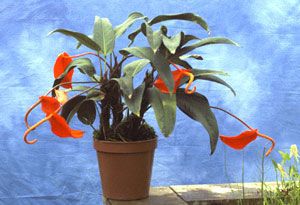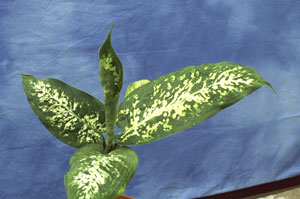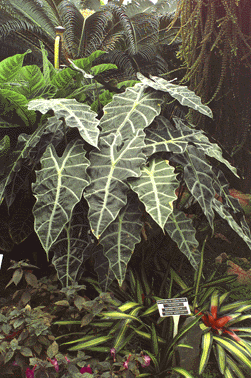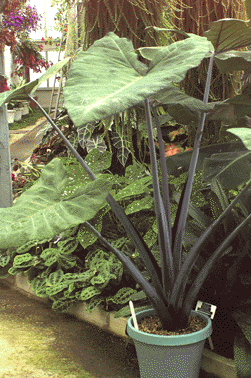Araceae: Aroid family
 Most aroids are herbs of the tropical or subtropical forest floor. They are often adapted to low light and high humidity, and have evolved broad dicot-like leaves. The most distinctive aroid feature is the inflorescence: tiny flowers embedded in a thick stalk called the spadix.
Most aroids are herbs of the tropical or subtropical forest floor. They are often adapted to low light and high humidity, and have evolved broad dicot-like leaves. The most distinctive aroid feature is the inflorescence: tiny flowers embedded in a thick stalk called the spadix.
The largest genus is Anthurium with 500 species. Right: Anthurium scherzerianum.
Several aroids, such as Philodendron and Dieffenbachia are well known as house plants. Part of their popularity is due to the fact that they require very little light because of their tropical forest origins. Below: Dieffenbachia picta exotica.

Edible aroids
 Aroids are food crops in many parts of the tropics, grown for their edible corms. The two genera below are grown as upland crops.
Aroids are food crops in many parts of the tropics, grown for their edible corms. The two genera below are grown as upland crops.
The Asian Alocasia is known as taro. It was probably native to Sri Lanka or India, whence it spread eastwards to Polynesia. Right: Alocasia x amazonica.
 Left: Xanthosoma violaceum is a South American crop aroid called cocoyam. It was cultivated by Amerindian people of the continent and Caribbean. During the slave-trading era, Xanthosoma was taken to Africa, and since the nineteenth century it has spread into the Pacific and Asia because of its resistance to disease and pests.
Left: Xanthosoma violaceum is a South American crop aroid called cocoyam. It was cultivated by Amerindian people of the continent and Caribbean. During the slave-trading era, Xanthosoma was taken to Africa, and since the nineteenth century it has spread into the Pacific and Asia because of its resistance to disease and pests.
